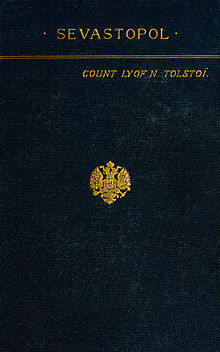Sevastopol Sketches
 Cover of the 1888 English edition. | |
| Author | Leo Tolstoy |
|---|---|
| Original title | Севастопольскіе разсказы |
| Translator | Frank D. Millet |
| Country | Russia |
| Language | Russian |
| Subject | Crimean War, philosophy of war |
Publication date | 1855 |
Published in English | 1887 (Harper) |
| Pages | 240 p. (Paperback) |
| Preceded by | The Decembrists (Abandoned and Unfinished) |
The Sevastopol Sketches, called in English translations the Sebastopol Sketches (pre-reform Russian: Севастопольскіе разсказы, tr. Sevastópolʹskiye razskázy; post-reform Russian: Севастопольские рассказы, tr. Sevastópolʹskiye rasskázy), also published in English as Sevastopol,[1] are three short stories written by Leo Tolstoy and published in 1855 to record his experiences during the Siege of Sevastopol (1854–1855). The name originates from Sevastopol, a city in Crimea. The book has also sometimes been entitled Sebastopol Stories. These brief "sketches" formed the basis of many of the episodes in Tolstoy's magnum opus, War and Peace.
Sketches[]
Sevastopol in December[]
In Sevastopol in December, Tolstoy uses second person narrative (with the pronoun 'you') in an introductory tour of life in Sevastopol. The detailed tour is arguably similar to one Tolstoy may have been given upon arrival in Sevastopol in November, 1854. As part of the tour, the narrator takes you through the dressing station, which is a makeshift hospital in the Assembly Hall. Here you find wounded soldiers, amputees, "some of them on camp beds, but most of them lying on the floor".[2] Tolstoy also uses Sevastopol in December to introduce the reader to the settings, mannerisms, and background he uses in Sevastopol in May and Sevastopol in August. For example, when referring to the enemy, either the British or the French, only the French are featured in the Sketches; they are referred to as "'him', as both soldiers and sailors say" (Tolstoy 198).
Sevastopol in May[]
In Sevastopol in May, Tolstoy examines the senselessness and vanity of war. The story examines many aspects of the psychology of war, heroism, and the misleading presence of humanism in truces (misleading because countries continuously go to war with one another, despite past truces). Tolstoy concludes by declaring that the only hero of his story is truth.
Sevastopol in August[]

Sevastopol in August depicts the conclusion of the siege of Sevastopol and the eventual defeat and withdrawal of the Russian forces. The narrative alternates between following Mikhail and Vladimir Kozeltsov, two brothers who both fight and eventually die for the Russian side of the conflict.
See also[]
References[]
- ^ Sevastopol, Project Gutenberg [1]
- ^ Tolstoy, Leo. The Cossacks and Other Stories. London, New York. Penguin, 2006. 188. Print.
External links[]
- English Text
- Sevastopol, from Marxists.org
- Sevastopol, from RevoltLib.com
- Sevastopol, from TheAnarchistLibrary.org
- English translation at Project Gutenberg (1888 translation by Isabel F. Hapgood)
- Books by Leo Tolstoy
- Works about the Crimean War
- 1855 books
- Second-person narrative fiction
- European history book stubs
- Russian history stubs
- Military history book stubs